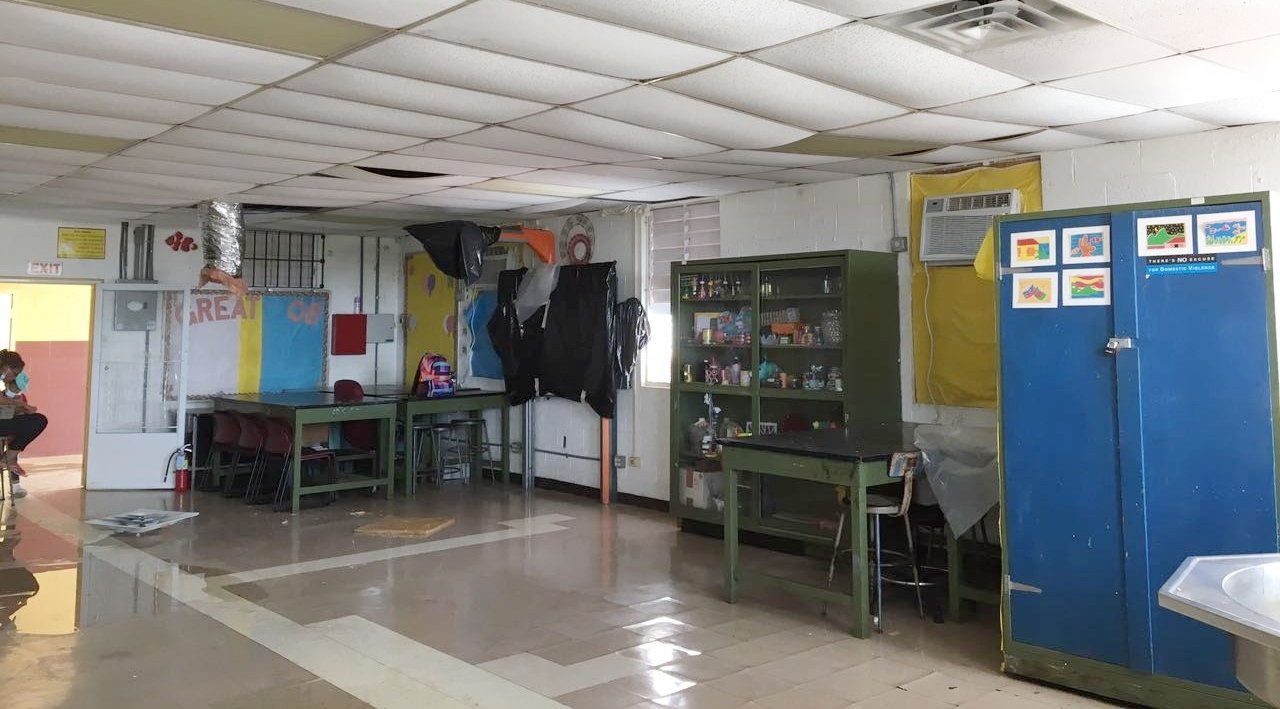Real-life hurricane-related experiences are brought into classroom learning
Territory educator creates a sanctuary for stressed students and incorporates real-life hurricane-related experiences into classroom learning
Ms. Michealrose Ravalier, Ivanna Eudora Kean High School, St. Thomas
Walking into Ms. Michealrose Ravalier’s classroom at Ivanna Eudora Kean High School on St. Thomas, students are invited to sit at tables with cheerfully patterned tablecloths. Bright-colored curtains decorate the windows – as Ms. Ravalier says, the bright colors bring light into the students’ lives, while they may not have light at home. There is no hint of mold behind the faint scent of air freshener. Most notably, her students gather in groups at tables, rather than sitting behind individual desks, which was a change that Ms. Ravalier incorporated this year. “When you’re stressed and don’t get to socialize, this makes [the stress of the hurricane impact] better,” she says.
This year, IEKHS (or “Kean” as the school is more commonly known), began its school year on October 16. The school day operates with normal pre-hurricane hours; not so for Addelita Cancryn Junior High School and Charlotte Amalie High School. Cancryn was condemned due to hurricane damage and those students have moved into Charlotte Amalie High School for split sessions: Cancryn in the morning; Charlotte Amalie in the afternoon. Elsewhere in the territory, multiple schools have been condemned and are operating under these split sessions, modified class times, and shared spaces.
Ms. Michealrose Ravalier spoke with Dr. Michele Guannel between the end of September and October, 2017, about her classroom’s recovery from Hurricanes Irma and Maria. Ms. Ravalier has been working with the Virgin Islands Institute for STEM Education Research and Practice (VI-ISERP) for more than one year, as a student in three semesters of the Action Research class (led by Dr. Nadia Monrose with support from Dr. Nastassia N. Jones and Dr. Michele Guannel). Ms. Ravalier is starting her third year of teaching after a career change. She is known by her students and colleagues for the supportive and creative ways that she engages her students in hands-on learning and in collaborative projects that support the development of her students as well-rounded humans – not simply as science learners.
Due to Hurricanes Irma and Maria, Ms. Ravalier’s classroom received substantial rainfall. Her ceiling tiles were engorged with moisture, and growing mold. Prior to the storms, she moved some of her classroom supplies to her home, and her textbooks survived the storms; however, there was a loss of art supplies that she intended to use with her students for their science projects. Immediately after Hurricane Irma, teachers began cleaning the school. After Hurricane Maria, teachers reported every day to school and some continued the cleaning process.
Ms. Ravalier’s high school science classroom, as of late September 2017. The floor was flooded, and ceiling tiles were full of moisture, damaged, or molding. Some of the classroom contents were damaged, such as the projector and most art supplies. Photo by Michealrose Ravalier
Over the course of several weeks, Ms. Ravalier and some of her students worked to clean the classroom of moisture and mold, transforming it into an inviting “Science Café.” Although Ms. Ravalier had originally intended to revitalize her classroom in this way prior to the hurricanes, she has found that elements of her interactive classroom seem to mitigate the stressful impacts of the hurricanes.
Ms. Ravalier chooses to give homework, but not too much – as most students don’t have electricity at home. She feels it is important to have consistency in the students’ experience. Another familiar ingredient of her classroom is bell work, which students complete either individually or in groups. On Friday, October 27, at the end of the first two full weeks of school, she posed this bell work assignment to her Biology 1 students: devise a method of distributing food supplies to disaster victims within three hours.
By early October, Ms. Ravalier had completed the entry to her classroom “Science Café,” complete with artwork on the door and cheerful tablecloths – though ceiling tiles still displayed evidence of Hurricanes Irma and Maria. Photo by Michealrose Ravalier.
Her experience is not without challenges, however. Even though schools have been back in recovery mode for several weeks, there is still no internet at school, so that, as Ms. Ravalier says, “you feel you’re not in the world.” Her projector, which she previously used on a regular basis to bring interactive displays to her students’ experience, is also not working. However, she continues to bring daily news to her lessons. For example, during the first week back to classes, students took apart a Meal-Ready-to-Eat (or MRE; an item distributed during disaster relief). She asked them to discuss: how can they improve the MRE, in terms of nutrition, cost, and palatability? As one of Ms. Ravalier’s favorite subjects is nutrition, the students analyzed the salt levels.
Because the school year lost six weeks, teachers are encouraged to make the best use of their time. While some might feel the need to cover as much content as possible, Ms. Ravalier is relying on her tried-and-true methods of project-based learning. She believes that incorporating even more hands-on, open-ended explorations into the classrooms will help with the healing and adjustment, post-hurricanes. Although everyone is feeling the stress of the “new normal” of life, Ms. Ravalier’s classroom offers a welcoming space where students can engage with one another and feel supported.
Guest post written by:
Michele Guannel, Ph.D.
Postdoctoral Research and Teaching Associate,
Virgin Islands Institute for STEM Education Research and Practice
Univerity of the Virgin Islands



